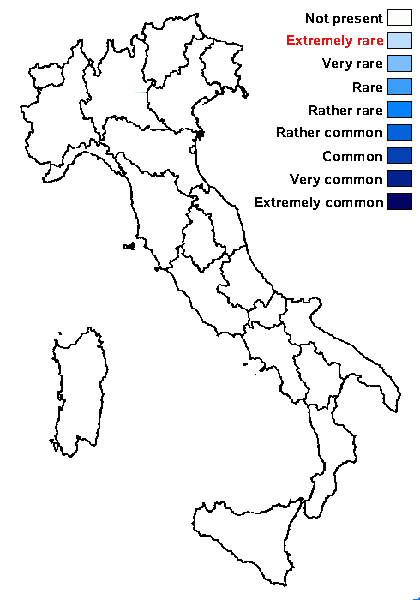Clavascidium imitans (Breuss) M. Prieto
in Prieto & al., Amer. J. Bot., 99, 1: 28, 2012. Basionym: Catapyrenium imitans Breuss - Linzer biol. Beitr., 24, 2: 813, 1992
Synonyms: Placidium imitans (Breuss) Breuss
Distribution:
Description: Thallus squamulose, medium brown, dull, non- or slightly pruinose, the squamules 3-6 mm broad, 0.2-0.3 mm thick, scattered to partially overlapping, with undulate, ascending margins. Lower surface pale brown, dark brown to almost black, attached by several, simple to weakly dichotomously branched, robust, up to 250 μm thick, pale to brown rhizines, and by less evident, colourless, 4-5 μm thick rhizohyphae which usually lack in the ascending marginal parts. Upper cortex paraplectenchymatous, 25-35 μm thick, with a thin epinecral layer, the cells not arranged in vertical rows; medulla with isodiametrical, subglobose, thick-walled cells throughout, well distinct from lower cortex; lower cortex paraplectenchymatous, brown in lower part, of more or less isodiametrical, 8-12 µm wide cells. Perithecia frequent, laminal, immersed in the squamules, broadly pyriform, up to 0.3 mm wide, without involucrellum, Exciple colourless to pale brown throughout; hymenial gel hemiamyloid; hamathecium of periphyses, interascal filaments absent. Asci 8-spored, cylindrical at least when young (sometimes turning clavate at maturity), thin-walled, I-, without a tholus, 70-75 x 10-13 µm. Ascospores 1-celled, hyaline, ellipsoid, thin-walled, uniseriate (or very rarely biseriate in mature asci), 12-15 x 6.5-8 μm. Pycnidia laminal, immersed, black, to 0.3 mm in diam., Dermatocarpon-type. Conidia bacilliform, 4-5.5 x 1-1.3 μm. Photobiont chlorococcoid. Spot tests: cortex and medulla K-, C-, KC-, P-, UV-. Chemistry: without lichen substances.Note: on soil in steppe-like vegetation; based on a type from Mongolia and apparently widespread in Asia, with a single record from the montane belt of the Western Alps (France), on gypsaceous soil. To be looked for in Italy, especially in the xerothermic Alpine valleys.
Growth form: Squamulose
Substrata: soil, terricolous mosses, and plant debris
Photobiont: green algae other than Trentepohlia
Reproductive strategy: mainly sexual
Subcontinental: restricted to areas with a dry-subcontinental climate (e.g. dry Alpine valleys, parts of Mediterranean Italy)

Predictive model
Growth form: Squamulose
Substrata: soil, terricolous mosses, and plant debris
Photobiont: green algae other than Trentepohlia
Reproductive strategy: mainly sexual
Subcontinental: restricted to areas with a dry-subcontinental climate (e.g. dry Alpine valleys, parts of Mediterranean Italy)

Predictive model
 INDEX FUNGORUM
INDEX FUNGORUM
 GBIF
GBIF


